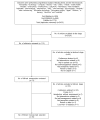Telehealth Interventions for Improving Self-Management in Patients With Hemophilia: Scoping Review of Clinical Studies
- PMID: 31293241
- PMCID: PMC6652120
- DOI: 10.2196/12340
Telehealth Interventions for Improving Self-Management in Patients With Hemophilia: Scoping Review of Clinical Studies
Abstract
Background: The introduction of home therapy for hemophilia has empowered patients and their families to manage the disease more independently. However, self-management of hemophilia is demanding and complex. The uses of innovative interventions delivered by telehealth routes such as social media and Web-based and mobile apps, may help monitor bleeding events and promote the appropriate use of clotting factors among patients with hemophilia.
Objective: This scoping review aims to summarize the literature evaluating the effectiveness of telehealth interventions for improving health outcomes in patients with hemophilia and provides direction for future research.
Methods: A search was conducted in Ovid MEDLINE, EMBASE, and PubMed databases for studies that (1) focused on patients with hemophilia A or B; (2) tested the use of remote telehealth interventions via the internet, wireless, satellite, telephone, and mobile phone media on patients and caregivers; and (3) reported on at least one of the following patient-/caregiver-focused outcomes related to empowering patients/caregivers to be active decision makers in the emotional, social, and medical management of the illness: quality of life, monitoring of bleeding episodes, joint damage or other measures of functional status, medication adherence, and patients' knowledge. Implementation outcomes (user metrics, cost saving, and accuracy of electronic records) were also evaluated. Reviews, commentaries, and case reports comprising ≤10 cases were excluded.
Results: Sixteen articles fulfilled the inclusion criteria. The majority of the interventions (10/16, 62%) evaluated both implementation outcomes and patient-/caregiver-focused outcomes. User performance and accuracy and comprehensiveness of electronic records were also measured in most studies (4/16, 87%). The components of the interventions were rather homogenous and typically involved electronic logging and reminders for prophylactic infusions, reporting of spontaneous and traumatic bleeding events, monitoring of infusion product usage and home inventory, and real-time communication with health care professionals and hemophilia clinics. Telemedicine-supported education and information interventions seemed to be particularly effective among adolescent and young adult patients. Although the patients reported improvements in their health-related quality of life and perception of illness, telemonitoring devices did not appear to have a significant effect on quantifiable health outcomes such as joint health. Longitudinal studies seemed to suggest that the response and adherence rates to recording decreased over time.
Conclusions: Preliminary evidence from this review suggests that telehealth-delivered interventions could feasibly improve patients' adherence to medication use and promote independence in disease management. Given the complexity and resources involved in developing a mature and established system, support from a dedicated network of hemophilia specialists and data managers will be required to maintain the technology, improve adherence to prophylactic treatment and recording, and validate the electronic data locally.
Keywords: adherence; clotting factors; hemophilia; self-management; telehealth.
©Wenji Qian, Teddy Tai-Ning Lam, Henry Hon Wai Lam, Chi-Kong Li, Yin Ting Cheung. Originally published in the Journal of Medical Internet Research (http://www.jmir.org), 10.07.2019.
Conflict of interest statement
Conflicts of Interest: None declared.
Figures
References
-
- Chen S. Economic costs of hemophilia and the impact of prophylactic treatment on patient management. Am J Manag Care. 2016 Apr;22(5 Suppl):s126–33. https://www.ajmc.com/pubMed.php?pii=86623 - PubMed
-
- Health Resources & Services Administration. 2018. [2019-06-21]. Telehealth Programs https://www.hrsa.gov/rural-health/telehealth/index.html. - PubMed
-
- Larsen SB, Sørensen NS, Petersen MG, Kjeldsen GF. Towards a shared service centre for telemedicine: Telemedicine in Denmark, and a possible way forward. Health Informatics J. 2016 Dec;22(4):815–827. doi: 10.1177/1460458215592042. http://europepmc.org/abstract/MED/26261216 - DOI - PMC - PubMed
-
- Hanlon P, Daines L, Campbell C, McKinstry B, Weller D, Pinnock H. Telehealth Interventions to Support Self-Management of Long-Term Conditions: A Systematic Metareview of Diabetes, Heart Failure, Asthma, Chronic Obstructive Pulmonary Disease, and Cancer. J Med Internet Res. 2017 Dec 17;19(5):e172. doi: 10.2196/jmir.6688. http://www.jmir.org/2017/5/e172/ - DOI - PMC - PubMed
Publication types
MeSH terms
LinkOut - more resources
Full Text Sources
Medical



